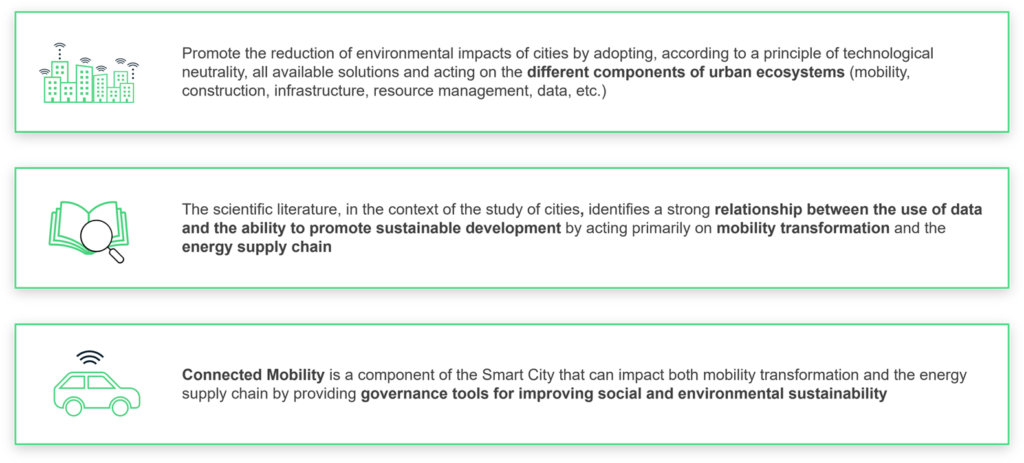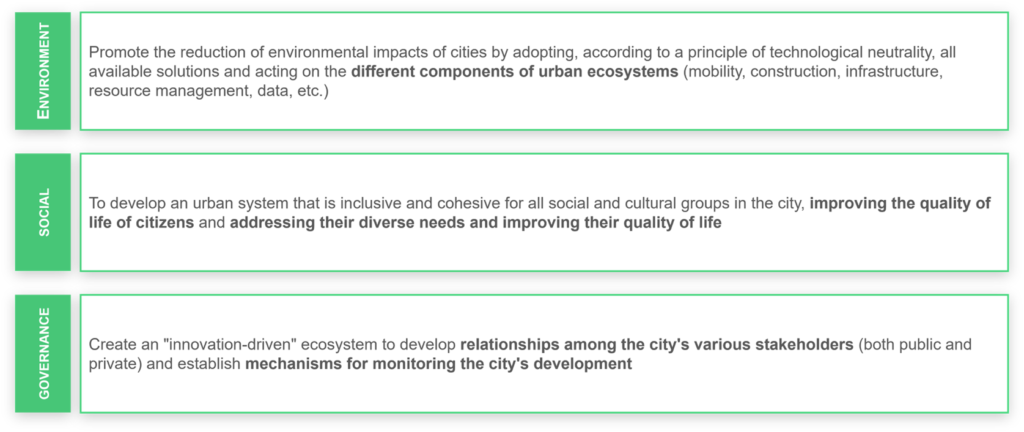For three years now, OCTO Telematics and The European House – Ambrosetti have been collaborating within the initiative “The Italian Way to Connected Mobility” with the aim of promoting a new mobility paradigm based on connected vehicle technologies that enable the digitization of mobility systems as an essential element for the development of Smart and Sustainable Cities.
In the previous two years of activity, OCTO and The European House – Ambrosetti have fostered the creation of a connected mobility ecosystem based on a principle of coopetition, to enable the collaboration of different stakeholdersas a condition for developing a new integrated model of mobility services. In addition, several priority use caseswere identified in 2022 by initiating a path to concretization through an intensive engagement activity with cities and related public administrations. This activity involved 12 actors between public and private for an open discussion on the possibilities and ways to facilitate the cities’ access to the innovation already owned by private companies with established know-how and experience on vertical sectors of connected mobility that can fertilize the context of smart cities.
During the 2023 edition, OCTO and The European House – Ambrosetti plan to take another step to support cities and build a “Sustainable Mobility Dashboard” to measure and evaluate the sustainability performance of mobility in urban areas and in the relationship with the surrounding area, thus introducing a new governancetool available to administrations.
This article, the first in the series that will report on the main results of the 2023 project activity, will focus on the need to promote sustainable development of cities, also emphasizing the medium-small towns that make up a significant share of our heritage, substantiated by the assessment on the state and evolution of urban and suburban settings and the analysis of academic literature.
As the chart shows, the joint analyses by OCTO and The European House – Ambrosetti are developed around three key messages, the first two of which are made explicit in this article.

Figure 1 Key messages from the first part of the analysis. Source: elaboration The European House – Ambrosetti, 2023
Large cities will increase globally inthe coming years. To date, globally, there are 33 megacities – that is, cities with more than 10 million inhabitants – that will become 43 in 2030, concentrated in Asian countries: in China alone, there are 102 cities with more than 1 million inhabitants and 6 megacities. In addition, the United Nations estimates that by 2050 more than 66% of the world’s population will live in cities (vs. 55% in 2020). It is crucial to consider that cities are the focal point of our economies. In fact, although they occupy less than 2% of the total land area, they produce 80% of the world’s GDP and more than 70% of CO2 emissions.
At the Italian level, there are seven metropolitan cities where more than a third of the regional population is concentrated: Rome (74%), Genoa (54%), Naples (53%), Turin (52%), Cagliari (34%), Milan (32%), and Bari (31%). However, considering that more than 84.8% of the Italian population lives in municipalities with less than 250 thousand inhabitants, it will be crucial to promote the development of connected and smart mobility initiatives in these realities as well, according to an “extended Smart City” logic.
In urban and suburban settings, it is crucial to take action to improve the quality of life for citizens. In particular, action is needed to mitigate the impact of road accidents and to improve travel management (commuting). Most accident deaths occur on urban and rural roads, both at the European (92%) and Italian (91%) levels. In Italy, commuting has been, pre-Covid, on the rise: in 2019, daily travellers increased by 5.1 percent (vs. 2011), from 2.79 million to 2.94 million.
The cities of the future will have to develop according to a sustainability-focused approach based on the ESG paradigm: Environment, Social, Governance.

Figure 2 The key principles for a sustainable city (ESG). Source: elaboration The European House – Ambrosetti, 2023
Such development of Cities, in addition to being driven by the systemic needs described above, is also required by the goals set at the European (Green Dealof the European Commission) and international (Sustainable Development Goals of the United Nations) levels, and some initiatives are being addressed at the national level to manage the transition.
For example, at the Italian level, Decree-Law No. 34 of May 19, 2020 (the Relaunch Decree, converted with amendments into Law No. 77 of July 17, 2020) introduced the “area mobility manager“, a figure who specializes in supporting the territorially competent municipality, to which he or she is appointed, in defining and implementing sustainable mobility policies and carrying out liaison activities between corporate mobility managers.
In order to further corroborate the analyses carried out and the centrality of smart mobility as a relevant topic for the realization of digital cities, The European House – Ambrosetti analyzed 41,084 academic paperson the topic of Smart City published worldwide in the last 10 years, a period in which publications have increased more than 9 times (from 803 to over 7,416), confirming the growing interest of the scientific community in this regard. 56% of the publications are concentrated in 5 countries: China, India, USA, Italy, UK.

Figure 3 Analysis of academic literature on the topic of Smart City. Source: elaboration The European House – Ambrosetti, 2023
The figure above represents the main key words emerging from the analysis of academic papersand the relationships between them. These words were grouped, through an Artificial Intelligence system, into thematic clusters- each identified by a different color. Three macrocategories were identified, namely:
- Expected result
- Sustainable growth of cities (in green)
- Areas of intervention
- Mobility (in blue)
- Energy (in yellow)
- Enabling technologies
- Big Data and analytics systems (in red)
- Connectivity and automation (in purple)
This analysis shows that Connected Mobility is central to the realization of the Smart City. Indeed, through Connected Mobility it is possible to improve vehicle and fleet management, optimize infrastructure and traffic management, as well as support transportation service planning and offer new services to citizens and drivers more in line with the sustainable growth of cities well summarized in OCTO’s Vision 0 (Zero Accidents, Zero Traffic, Zero Pollution). By acting immediately on the negative externalities of mobility, the Connected Mobility Ecosystem offers a possible avenue for managing the energy transition by acting on vehicles, infrastructure and all IoT and Intelligent Transport System technologies. Among the Smart City enabling technologies, connected vehicles and infrastructure, as well as the Intelligent Transport System, play a key role.
As anticipated in the opening introduction, as early as 2021 OCTO and The European House – Ambrosetti identified 14 priority Use Casesofcities and businesses to implement Vision Zero (Zero Traffic, Zero Pollution, Zero Accidents). As of today, thanks to a constant evolution of telematics, a rethinking of urban mobility is possible that can evolve from systems of “inhibiting access to restricted areas” to the possibility of flexibly managing access based on individual needs and behaviors using already widespread technologies for connected vehicles such as black boxes or natively connected cars or recently even using specific smartphone apps that perform route and driving style monitoring and allow two-way, personalized communication with the citizen, which can be integrated with other city services (e.g., MaaS). Finally, data can be collected directly from connected vehicles without using external solutions.
In order to understand the role of connected technologies and, in particular, Connected Mobility in enabling a new paradigm of sustainable urban development, The European House – Ambrosetti mapped the world’s leading Smart Cities, identifying 165 Smart City projects, which are characterized by being enabled by the creation of interconnected ecosystems for data exchange. These include some examples of activities carried out with reference to mobility:
- New York City is considered the most advanced Smart City thanks to a development vision based on the use of data collected on its territory. NYC has earmarked $110 billion to accelerate its transformation into a Smart City over the next 10 years. These resources will be used to support the reduction of climate-changing emissions and the development of connected infrastructure in the city. The city has set a goal to reduce accidents, traffic and pollution to zero by promoting the deployment of Connected Mobility with a special focus on 9 areas of action, including: traffic control, safety management, route optimization, etc.
- “Smarter LondonTogether” Roadmap was developed by the City of London and is based on sharing data, creating smartinfrastructure, and introducing technological innovations. The Plan’s goals include reducing private mobility-related traffic by 27% and zeroing CO2 both by 2030.
- The Smart City of Barcelona is defining its mobility plan through the construction of a Digital Twin. Through the collection and analysis of such data and the involvement of private parties, the City aims to increase the accessibility of digital public services and the amount of Open Data by promoting an increasingly accessible mobility model.
It is therefore clear from the analyses conducted that connected and sustainable mobility should be considered an essential and enabling element in the creation of a new city model. In the next article in this series, we will focus on the third key message devoted to the opportunity to measure the ESG performance of mobility in a data-driven manner. That article will present a first draft of the model underlying the Sustainable Mobility Dashboard created by OCTO and The European House – Ambrosetti.
Author:
The European House – Ambrosetti